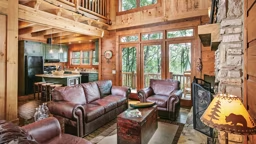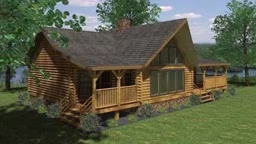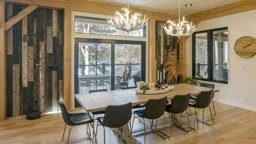Christian and Angela Goebel have plenty of experience with log homes: Christian has built 10 tiny cabins that serve as rentals in Virginia’s Shenandoah Valley.
 When it came time to add another cabin to their 7-acre Cast-a-Way Cabins community, they decided that this time around, bigger would be a bit better.
When it came time to add another cabin to their 7-acre Cast-a-Way Cabins community, they decided that this time around, bigger would be a bit better.
Why a log home: “There’s something about a rustic log cabin that’s very appealing,” Christian says. “It’s in keeping with the majestic Blue Ridge Mountains.”
From their experience with people looking for a vacation getaway, the Goebels know that log homes are a perennial attraction in every season.
Most important features: The Goebels wanted this new cabin to be large enough to hold three bedrooms and two full baths, but still wanted to maintain a fairly small footprint.
The living area had to offer enough space for a family to relax, as well as a fully equipped kitchen. “People have higher expectations,” Christian says, even when they are looking for a “rustic” vacation spot.
While their other two-bedroom rentals have lofts that serve as seating areas with pull-out sofas, the Goebels wanted this cabin to have a third true bedroom suite upstairs.

The Lowdown
The Goebels turned to their trusted partner, Conestoga Log Cabins & Homes in Lebanon, Pennsylvania, for help. (Conestoga supplied the packages for all of the other homes Christian has built.) They started with Conestoga’s Mountain Haven model and made a few adjustments. “This model provides two-story living within a reasonable budget,” says Ronald Myer of Conestoga. “The loft can be open or closed.”

The Inside Scoop
If you plan to purchase a log package, it can be confusing to directly compare what various log home companies offer. To help you navigate your options, Ronald provides these suggestions:
- Study the contents of the package/kit. “Ask for a materials list to see what is truly included,” Ronald says. For example, “roofing” may mean just structural roof members for some companies, others might include shingles and other finishing materials.
- Bring in your builder. Ask your builder to review the materials list from a professional standpoint to let you know what you might have to purchase on your own.
- Evaluate the level of pre-cutting. Especially if you plan to build the home yourself, you might want a kit with pre-cut logs to reduce the amount of cutting you would need to do on site.











